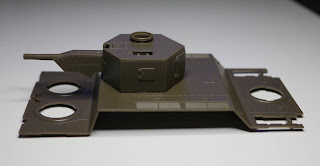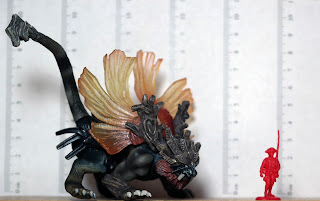The actual appearance of the O-I super heavy tank has been shrouded in mystery for decades, leaving model manufacturers to produce their own renditions of the tank based on sketchy details and pure conjecture.
 |
| 1/144 100 ton tank from Matuo Kasten (マツオカステン) |
 |
| 1/144 100 ton tank from Atelier Infinite (アトリエ インフィニティー) |
 |
| 1/144 120 ton tank from Atelier Infinite |
 |
| 1/72 tank from World at Arms |
Recently however, records and plans related to the tank were recovered by Kunihiro Suzuki (president of Fine Molds) [1],[2]. The material was found at Wakajishi Shrine, built on the site of the Army Youth Tank School (陸軍少年戦車兵学校), which was associated with the Chiba Army Tank School (千葉陸軍戦車学校).
With the blueprints on hand, Fine Molds announced the release of a 1/72 O-I tank, and promoted the kit along with Wargaming.net which had announced the addition of a digital version of the O-I (drawn up from the same plans) to the World of Tanks online game.
 |
| Wargaming Japan O-I tank display at the 2015 Tokyo Game Show |
I pre-ordered the kit when it was first announced, but the model has only recently arrived from Japan, having sat in my "private warehouse" at HLJ since December.
 |
| I like the box art, but my box has an ugly WoT advertising sticker on it... |
The box contained marketing material for World of Tanks and Girls und Panzer.
 |
| 招待コード を 与える 最初 の メール |
Just looking at the size of the upper hull makes the model seem more like a 1/48 scale kit than a 1/72 scale kit.
 |
| The upper hull is 66mm wide! |
Decals include options for six different tank units. I will go with markings for the 35th Tank Regiment (2) for my tank.
The 35th, along with the 34th, 51st, and 52nd Tank Regiments would have been stationed in Manchuria near the close of WWII.
The other regiments represented on the decal sheet may have been among the 10 original regiments stationed in Manchuria (I didn't bother verifying if they were or not), but historically they are more closely associated with other regions like Saipan, the Philippines, Malaya, etc.
I'm assembling the tank pretty much out of the box. The instructions are straight forward, though I'm not sure why step 4 asks you to drill a hole in a location where a hole already exists.
The assembly of the 47mm cannons for the smaller turrets is overly complex, and makes the barrel structurally weak.
If you actually want the barrel to pivot, I would recommend modifying C22 so that it does not fit so tightly in C20.
The design and fit of the main gun is a lot better, but be sure to fit B11 into B20 before attaching the barrel.
The turret has a simple hexagonal cross section as shown in the plans, but I can't help but think that the actual production turret would have been more like the 6-sided turret used for the Chi-Ri.
To be continued...



















































